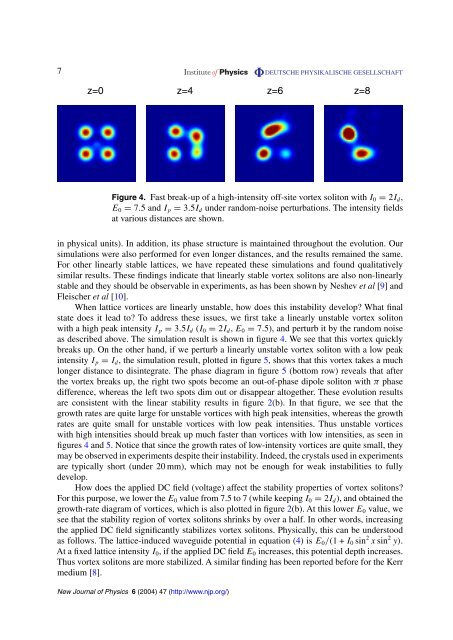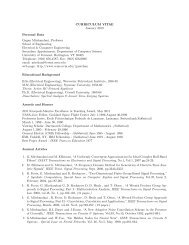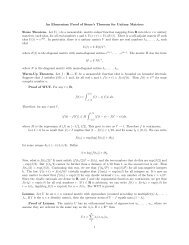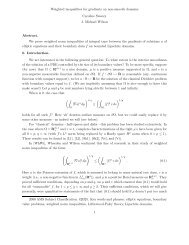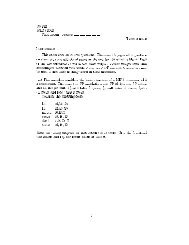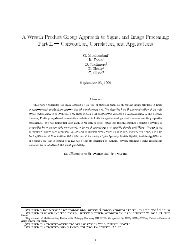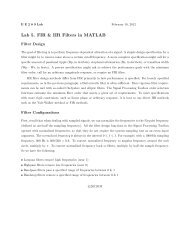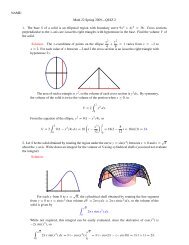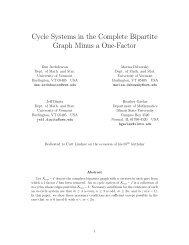Stability of vortex solitons in a photorefractive optical lattice
Stability of vortex solitons in a photorefractive optical lattice
Stability of vortex solitons in a photorefractive optical lattice
Create successful ePaper yourself
Turn your PDF publications into a flip-book with our unique Google optimized e-Paper software.
7 DEUTSCHE PHYSIKALISCHE GESELLSCHAFTz=0 z=4 z=6 z=8Figure 4. Fast break-up <strong>of</strong> a high-<strong>in</strong>tensity <strong>of</strong>f-site <strong>vortex</strong> soliton with I 0 = 2I d ,E 0 = 7.5 and I p = 3.5I d under random-noise perturbations. The <strong>in</strong>tensity fieldsat various distances are shown.<strong>in</strong> physical units). In addition, its phase structure is ma<strong>in</strong>ta<strong>in</strong>ed throughout the evolution. Oursimulations were also performed for even longer distances, and the results rema<strong>in</strong>ed the same.For other l<strong>in</strong>early stable <strong>lattice</strong>s, we have repeated these simulations and found qualitativelysimilar results. These f<strong>in</strong>d<strong>in</strong>gs <strong>in</strong>dicate that l<strong>in</strong>early stable <strong>vortex</strong> <strong>solitons</strong> are also non-l<strong>in</strong>earlystable and they should be observable <strong>in</strong> experiments, as has been shown by Neshev et al [9] andFleischer et al [10].When <strong>lattice</strong> vortices are l<strong>in</strong>early unstable, how does this <strong>in</strong>stability develop? What f<strong>in</strong>alstate does it lead to? To address these issues, we first take a l<strong>in</strong>early unstable <strong>vortex</strong> solitonwith a high peak <strong>in</strong>tensity I p = 3.5I d (I 0 = 2I d ,E 0 = 7.5), and perturb it by the random noiseas described above. The simulation result is shown <strong>in</strong> figure 4. We see that this <strong>vortex</strong> quicklybreaks up. On the other hand, if we perturb a l<strong>in</strong>early unstable <strong>vortex</strong> soliton with a low peak<strong>in</strong>tensity I p = I d , the simulation result, plotted <strong>in</strong> figure 5, shows that this <strong>vortex</strong> takes a muchlonger distance to dis<strong>in</strong>tegrate. The phase diagram <strong>in</strong> figure 5 (bottom row) reveals that afterthe <strong>vortex</strong> breaks up, the right two spots become an out-<strong>of</strong>-phase dipole soliton with π phasedifference, whereas the left two spots dim out or disappear altogether. These evolution resultsare consistent with the l<strong>in</strong>ear stability results <strong>in</strong> figure 2(b). In that figure, we see that thegrowth rates are quite large for unstable vortices with high peak <strong>in</strong>tensities, whereas the growthrates are quite small for unstable vortices with low peak <strong>in</strong>tensities. Thus unstable vorticeswith high <strong>in</strong>tensities should break up much faster than vortices with low <strong>in</strong>tensities, as seen <strong>in</strong>figures 4 and 5. Notice that s<strong>in</strong>ce the growth rates <strong>of</strong> low-<strong>in</strong>tensity vortices are quite small, theymay be observed <strong>in</strong> experiments despite their <strong>in</strong>stability. Indeed, the crystals used <strong>in</strong> experimentsare typically short (under 20 mm), which may not be enough for weak <strong>in</strong>stabilities to fullydevelop.How does the applied DC field (voltage) affect the stability properties <strong>of</strong> <strong>vortex</strong> <strong>solitons</strong>?For this purpose, we lower the E 0 value from 7.5 to 7 (while keep<strong>in</strong>g I 0 = 2I d ), and obta<strong>in</strong>ed thegrowth-rate diagram <strong>of</strong> vortices, which is also plotted <strong>in</strong> figure 2(b). At this lower E 0 value, wesee that the stability region <strong>of</strong> <strong>vortex</strong> <strong>solitons</strong> shr<strong>in</strong>ks by over a half. In other words, <strong>in</strong>creas<strong>in</strong>gthe applied DC field significantly stabilizes <strong>vortex</strong> <strong>solitons</strong>. Physically, this can be understoodas follows. The <strong>lattice</strong>-<strong>in</strong>duced waveguide potential <strong>in</strong> equation (4) isE 0 /(1+I 0 s<strong>in</strong> 2 x s<strong>in</strong> 2 y).At a fixed <strong>lattice</strong> <strong>in</strong>tensity I 0 , if the applied DC field E 0 <strong>in</strong>creases, this potential depth <strong>in</strong>creases.Thus <strong>vortex</strong> <strong>solitons</strong> are more stabilized. A similar f<strong>in</strong>d<strong>in</strong>g has been reported before for the Kerrmedium [8].New Journal <strong>of</strong> Physics 6 (2004) 47 (http://www.njp.org/)


